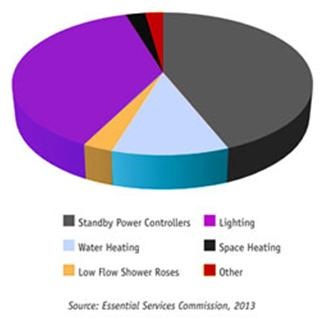Victoria's energy savings test
It seems yet another successful complementary energy saving program faces the chop.
The Victorian government review of the Energy Saver Incentive will be a key test of the Coalition’s consistency on Direct Action. Submissions closed on Monday and the ball now sits at the feet of Premier Denis Napthine and his new energy minister, Nick Kotsiras.
The ESI was previously known as the Victorian Energy Efficiency Target and is administered by the Essential Services Commission. It is a “white certificate” type scheme whereby retailers of electricity are required to buy certificates created by third parties who deliver energy savings through targeted programs in the commercial and domestic sector.
The scheme initially had an annual target of reducing lifetime GHG emissions by 2.7 million tonnes per annum in the residential sector, which was doubled to 5.4 million per annum for the 2012-14 period and expanded to include business and other non-residential sectors. Its current phase is due to end on December 31, 2014.
According to the Issues paper, the ESI is estimated to have so far saved energy equivalent to 13.5 million tonnes of avoided lifetime GHG emissions.
Since the Napthine reshuffle, energy policy is now the responsibility of the Department of State Development, Business and Innovation (DSDBI). It is preparing a regulatory impact statement (RIS) to “review both the effectiveness of the scheme to date and the need for the scheme to continue.”
An issues paper, released on June 7, sought stakeholder views as part of the development process for the RIS – however only four weeks were allowed and it is unclear how strong the response has been. Stakeholders were asked to comment on:
-- Barriers to the uptake of energy efficiency measures;
-- The performance of the ESI to date; and
-- The future of the scheme from 2015.
There is a strong suggestion that the underlying agenda is to justify the scrapping of what otherwise has been a successful scheme. The questions posed in the issues paper are clearly canvassing the options of abolition or a phase out of the scheme.
However, legislation was recently passed to expand the ESI scheme to include street lighting upgrades. This was to compensate local government for the broken promise to provide $20 million through the Green Light Plan to accelerate the replacement of old, inefficient street lights with more efficient bulbs.
The Green Light Plan was scrapped in the 2012 Victorian budget despite a very positive review conducted only months earlier. If the ESI scheme is now itself ditched, the Green Light Plan will have the unusual distinction of having been scrapped twice.
Previous modelling undertaken by government in 2011 suggested that there would be downward pressure on overall energy prices due to cost reductions and energy savings achieved through the ESI, such as reduced energy generation costs.
Data provided by the ESC suggests that most of the certificate creation has been in relation to standby power controllers, lighting and water heating with small contributions from low flow shower rose installations and space heating improvements.

The principal criticism of the ESI has been the large role played by standby energy controllers and, in particular, the use of door-to-door distributors dispensing these free to householders. Relying on backpackers and poorly trained staff raises concern that the estimated benefits in reducing standby power will not be achieved if householders don’t use the devices properly.
Limited surveys suggest this is an issue, although the majority of standby controllers are being used as intended. The reliance on door-to-door distributors and the further distribution of stand by devices could reasonably be wound back as part of the review. These problems should not be used as a pretext for abolition.
Coalition state governments have systematically scrapped or downgraded climate change and energy efficiency programs they have inherited – frequently using the excuse that these “complementary measures” are now duplicating the impact of the carbon price.
However, carbon pricing cannot succeed if it is the sole strategy to save energy and reduce greenhouse emissions. The benefit of targeted complementary programs is they provide market mechanisms to redistribute benefits to give incentives to those in a position to take effective action.
These cutbacks by Coalition states highlight a contradiction with the federal Coalition Direct Action policy which is dependent on achieving its goal of a 5 per cent reduction in greenhouse gas emissions by targeted programs to reduce energy use. Most of the targeted programs are in areas of state responsibility.
The strong climate sceptic faction within the Coalition perceives all forms of government intervention on energy efficiency as wasteful and unnecessary and a driving force for price increases.
This ignores the undoubted relationship between economic efficiency and energy efficiency for business and more directly for householders, the potential for energy savings to reduce cost of living pressures.
Domestic consumers and small business get only an indirect incentive from the carbon price. The impact of the current modest level of carbon pricing is dwarfed by the price rises in recent years due to other cost pressures on electricity retailers and distributors.
However there are huge benefits for generators and distributors to avoid expensive investment if they can reduce demand, particularly at peak times.
The Energy Saver Incentive enables consumers to share these benefits that generators and distributors get from cutting their investment in new standby capacity and distribution assets. Without such a scheme the efforts of consumers to reduce overall demand and manage their peak loads would go unrewarded.
Andrew Herington is a former Labor Ministerial Adviser and now a Melbourne freelance writer.
















